Candida
Martinelli's Italophile Site

Main
Page This family-friendly site celebrates Italian culture for the enjoyment of children and
adults. Site-Overview

 |
Historical
Novels
set in Italy
|

Books
Children
Thrillers
Mysteries
Old Rome
Romances
|
|
My Two New Italophile Sites
Italophile Book Reviews offers personal views on many books that
might interest lovers of Italy. Authors and Publishers: I
review books set in Italy, or about Italy and Italian culture, or about
hyphenated Italian culture. My site is family-friendly. Indie (Self)
published books, and small publishing houses are welcome. Contact:
info @ italophiles.com
Italophile Books is
an Amazon.com linked shop that has only products Italophiles are sure to
love. Shop with no distractions! You can click through to
the full Amazon.com site at any time, keeping your shopping cart.
Checkout is through Amazon.com's usual secure system.
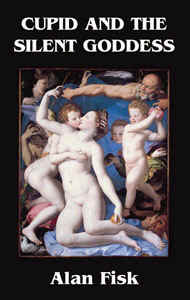
(I've read this book and I can recommend it highly. It
brought me into the 16th century Florentine life, with all it's warts,
humanity, politics and art. A very enjoyable read. It's set
during the time of Cosimo de' Medici, and features the artist Bronzino. Candida
Martinelli)
Mysteries
set in Italy
Mysteries
set in Ancient Rome
Non-fiction
books about Italy
Romances
set in Italy
Thrillers
Set in Italy
Children's
Books
Italian
Bestselling Writers
|
The books featured here are historical novels set in Italy.
I've included some featuring:
- Ancient Roman warfare
- World War II in Italy
- Famous works of art
- 13th - early 20th Century Italy
Each book is linked via a click on the book cover, to Amazon.com's
page for the book. Some allow you to Search Inside
the book.
There you can find excerpts, sometimes links to the first chapter,
back cover text, and prices for new and used copies.
Many of these books are available as paperbacks and Kindle
e-books, so be sure to
check before deciding one's too expensive.
These links go directly to Amazon.com's pages for Kindle books.
Kindle Historical Italy Romances
Italy
Kindle Historical Fiction
|
|
|
Visit my Historical Romance page or my page
Mystery Series set in Ancient Rome for more
historical novels. |
|
|
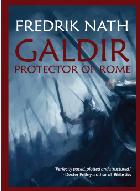 Galdir
- Protector of Rome by Fredrik Nath Galdir
- Protector of Rome by Fredrik Nath
Galdir, a Warlord of the Franks, is a tall, blonde,
battle-scared German warrior in his early thirties when this book begins
in Rome, circa 180 A.D. After adventures that are detailed in Galdir
- A Slave's Tale and Galdir - Rebel of the North, Galdir is
now a bodyguard for the gorgeous widow of a Roman patrician. Galdir's
story in Protector of Rome, written in the first person later in
his storied life, begins on October 22, 180, the day of the Emperor
Commodus's Triumph.
Galdir - Protector of Rome is actually three
books in one. It is divided into these three sections: Commodus the
Emperor, Duras the King, Galdir the Warlord. Each of the three
sections could easily have been issued as a separate novel. When you
purchase a Galdir book, you get your money's worth! You have hundreds
of pages of action, and a front row view of Ancient Roman history.
I don't wish to post any spoilers here, so I'll
just say that Galdir plays the cards he has to gain what he wants for
himself and for his people. Those cards demand much sacrifice and
physical suffering, as well as a continual struggle to keep his honor
while living at the center of the corrupt capital of the disintegrating
Roman Empire.
Galdir's almost childlike embrace of honor and duty
and love makes him blind, at times, to the deceit around him, which is
perhaps why he is not completely contaminated by it.
The books in the Galdir Saga series follow
Galdir from child barbarian, to slave, to rebel soldier, to bodyguard,
to royal bodyguard, and finally to the tribal leader he was born to
become.
Galdir - Protector of Rome is a
well-written, well-edited, richly imagined, well-researched book full of
period detail, especially expert in military details and the description
of the frequent fight and battle scenes. It is an adventure saga that
does not disappoint.
Read my
full review at
Italophile Book Reviews.
|
|
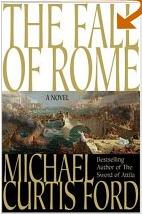 The
Fall of Rome by Michael Curtis Ford The
Fall of Rome by Michael Curtis FordFrom Amazon.com:
"In his riveting novel The Sword of Attila,
Michael Curtis Ford thrilled readers with his recounting
of a cataclysmic clash of ancient civilizations. Now, in
The Fall of Rome, he takes on the bloody twilight
of empire, as the legacy of Attila---once thought
destroyed on the battlefield---emerges again to defy the
power of the Western World.
'In this powerful saga of Roman warfare, the sons of
Attila’s great officers wage battle with one another as
the dramatic confrontation between Rome’s last emperor
and Rome’s barbarian conqueror leads to the thrilling
dénouement that becomes the fall of a mighty empire.
'Pulsing with intrigue, saturated with historical
detail, The Fall of Rome brings readers to new
places—pressed into the trenches as catapult bolts fly
overhead, lurking within the palace where betrayal is
plotted, imprisoned in a tower stronghold where an
emperor turns mad."
|
|
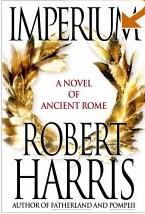 Imperium
by Robert Harris Imperium
by Robert HarrisFrom Publisher's Weekly:
Bestselling British author Harris (Pompeii; Enigma)
returns to ancient Rome for this entertaining and enlightening novel of
Marcus Cicero's rise to power.
Narrated by a household slave named Tiro, who actually served as
Cicero's "confidential secretary" for 36 years, this fictional biography
follows the statesman and orator from his early career as an outsider—a
"new man" from the provinces—to his election to the consulship, Rome's
highest office, in 64 B.C.
The author's newest novel, Lustrum, continues the Cicero story
to it's sad conclusion. It is not yet on release everywhere.
When I can put a direct link, I shall.
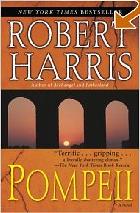 Pompeii
by Robert Harris Pompeii
by Robert Harris
From A Reader's Review:
It is August of 79 A.D. in the Bay of Naples and the Aqua Augusta,
the aqueduct carrying water to the cities of the area, begins to dry up.
Fish are mysteriously dying in their ponds. There are ground tremors and
rock falls in the cities surrounding Mount Vesuvius.
Some residents attribute these things to giants or to the wrath of
the gods. But Marcus Attilius Primus, the aquarius, or water engineer of
the Aqua Augusta, who is sent to Misenum to research and repair the
problem, knows that there is a scientific explanation.
As he tracks the aqueduct from its terminus in Misenum to Pompeii and
then onward to the vicinity of Mount Vesuvius, he observes unusual
natural phenomena, discovers the upheaval that disrupted the water flow,
and realizes that an inevitable cataclysmic event is about to occur. |
|
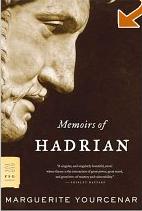 Memoirs
of Hadrian by Marguerite Yourcenar Memoirs
of Hadrian by Marguerite YourcenarFrom Amazon.com: "Both an
exploration of character and a reflection on the meaning of history,
Memoirs of Hadrian has received international acclaim since its
first publication in France in 1951. In it, Marguerite Yourcenar
reimagines the Emperor Hadrian's arduous boyhood, his triumphs and
reversals, and finally, as emperor, his gradual reordering of a war-torn
world, writing with the imaginative insight of a great writer of the
twentieth century while crafting a prose style as elegant and precise as
those of the Latin stylists of Hadrian's own era.
|
|
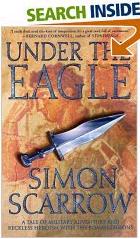 Under the Eagle Under the Eagle by
Simon Scarrow by
Simon Scarrow
From Booklist:
"It is the year 42 AD, and Centurion Macro,
battle-scarred and fearless, is in the heart of Germany with the Second
Legion, the toughest in the Roman army. Cato, a new recruit and the
newly appointed second-in-command to Macro, will have more to prove than
most.
In a bloody skirmish with local tribes, Cato gets his first chance
to prove that he's more than a callow, privileged youth. As their next
campaign takes them to a land of unparalleled barbarity - Britain - a
special mission unfolds, thrusting Cato and Macro headlong into a
conspiracy that threatens to topple the Emperor himself."
|
|
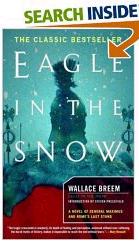 Eagle in the Snow Eagle in the Snow by
Wallace Breem by
Wallace Breem
From Amazon.com:
"Banished to the Empire’s farthest
outpost, veteran warrior Paulinus Maximus defends The Wall of Britannia
from the constant onslaught of belligerent barbarian tribes. Bravery,
loyalty, experience, and success lead to Maximus’ appointment as
"General of the West" by the Roman emperor, the ambition of a
lifetime. But with the title comes a caveat: Maximus needs to muster and
command a single legion to defend the perilous Rhine frontier."
While not set in Rome, it is about the fall of the Roman Empire.
I've more about this book, which was used
as inspiration for the film Gladiator, and a very interesting profile
of Mr. Breem, who has been an inspiration to historical novelists
since this novel first came out in 1970. You'll find many elements
of his novels and characters in the books by Lindsay Davis (Marcus
Didius Falco Mystery Series) and Steven Saylor (Gordianus the Finder
Mystery series). And
the Italian novelist Valerio Massimo
Manfredi's book The Last Legion, which was made into a film
of the same name, takes up the Excalibur plotline that is suggested
by a line near the end of Eagle in the Snow.
|
|
|
The Legate's Daughter by Wallace Breem I have read this book (C.M.)
and I found it an intriguing read. The author departs from his
first book (Eagle in the Snow) which shows in intimate detail the
skills and character needed to head an Ancient Roman legion at the
border of the Empire. Instead, The Legate's Daughter shows
in intimate detail the skills and characters needed to run a
diplomatic mission at the edge of the Ancient Roman Empire.
The reader is put in the position of a diplomat, someone who must
collect gossip, read people, and read between the lines in this
third-person narrated novel. Nothing
is spelled out for the reader. We must move along with the
characters and try to cipher out the truth, the good guys and the bad
guys from the events, glances, words, sighs, and chance encounters.
The protagonist is Curtius Rufus. He is spotted by Maecenas, a
real-life master diplomat, and by Marcus Agrippa, a real-life soldier
and administrator, who has had to rely on Maecenas's diplomatic skills
more then once. The two men tutor Curtius, then send him on a
delicate and impossible mission: to recover the daughter of a
Roman patrician and senator, who has been taken by force from Spain and
who is likely hidden somewhere in North Africa.
Breen has created in Curtius Rufus a whole character, full of
contradictions, talents, weaknesses and all the natural skills needed by
a diplomat who has to deal with the tribes at the edge of the Roman
Empire: guile, intuition, sharp reasoning, people reading,
languages, gossip mongering, seduction, conversation that convinces and
that induces confidence, patience, tactical tricks, leadership,
sacrifice, friendship, loyalty.
Curtius is a man in a man's world, but he also understands
those at the weak end of the harsh society: the slaves (his father
was one), the freedmen (he is one), the Roman outsiders (his best friend
is one), the women (his greatest skill is his ability to seduce and
please women).
It is possible that Breem created his character with
the historian/politician Quintus Curtius Rufus, sometimes called Curtius
Rufus, in mind. The Roman writer Tacitus tells us what little we
know about Rufus, and it fits very closely with Breem's character, in
moody temperament and ambitious new-man status, which was a self-made
man from obscure birth. That would mean that Breem's Rufus goes on
after the end of the book to have a very long life and career leading to
a Praetorship, a Consulship, a Triumph (not for military triumphs but
for commercial ones), and as a writer, and lastly as Proconsul of
Africa, where he presumably died, a very old man.
The book is rich with period detail, so rich that it seems to be
written by someone who lived through the events described. No, I
mean REALLY lived there. So many historical novels purport to be
first person accounts of events and fall short, but we make excuses for
the writer, saying "Well, it is set in in a date from before the birth
of Christ...". This book has the richness that leaves you feeling
that you have visited the times and places described.
This is not an easy read. Many times I had to set the book down
and head for the Internet to look up the history, geography and people
of Ancient Rome. I'm not complaining. I enjoyed that.
But a warning to readers who like everything handed to them on a
plate: to read the book without the historical information would
be a waste of time. Breem's first novel was written as a gift to
his wife. This novel reads like a gift to every classicist on the
planet. There is so much for the knowledgeable reading to enjoy.
This means that you, the reader, must assemble the plot in
your mind as you read, as if you were decoding a diplomatic message.
Challenging, yes.
Rewarding, most definitely yes! It is the kind
of book that you read to the last page then you start all over again at
page one, to make sure you've really understood everything that
happened. I read it, did lots of research, then read it again, and
I enjoyed it even more the second time around! |
|
|
Julian by Gore Vidal From the book description: "The
remarkable bestseller about the fourth-century Roman emperor who
famously tried to halt the spread of Christianity, Julian
is widely regarded as one of Gore Vidal’s finest historical novels.
"Julian the Apostate, nephew of Constantine the Great, was one of the
brightest yet briefest lights in the history of the Roman Empire. A
military genius on the level of Julius Caesar and Alexander the Great, a
graceful and persuasive essayist, and a philosopher devoted to
worshipping the gods of Hellenism, he became embroiled in a fierce
intellectual war with Christianity that provoked his murder at the age
of thirty-two, only four years into his brilliantly humane and
compassionate reign. A marvelously imaginative and insightful novel of
classical antiquity, Julian captures the religious and
political ferment of a desperate age and restores with blazing wit and
vigor the legacy of an impassioned ruler."
“A subtle, provoking, enthralling book. . . . Vidal’s ability to
invoke a world is amazing.” —The Christian Science Monitor
“Simply great. . . . A truly monumental novel.” —Associated Press
“Historical fiction in the true, honorable sense. . . . Full of
vivid, richly wrought fictional detail.” —The Wall Street Journal |
|
|
I, Claudius by Robert Graves From this classic book's
description:
"Historical novel set in 1st-century-AD Rome by Robert Graves,
published in 1934. The book is written as an autobiographical
memoir by Roman emperor Claudius. Physically weak, afflicted with
stammering, and inclined to drool, Claudius is an embarrassment to his
family and is shunted to the background of imperial affairs.
"The benefits of his seeming ineffectuality are twofold: he becomes a
scholar and historian, and he is spared the worst cruelties inflicted on
the imperial family by its own members during the reigns of Augustus,
Tiberius, and Caligula. Palace intrigues and murders surround him.
Claudius' informal narration serves to emphasize the banality of the
imperial family's endless greed and lust. The story concludes with
Claudius ascending to the imperial throne.
"A sequel, Claudius, the God and His Wife Messalina (1935), covers
Claudius' years as Roman emperor."
|
|
|
Augustus, A Novel by John Edward Williams Book description:
"A brilliant and beautifully written novel in the tradition of Robert
Graves’ I, Claudius, Augustus is a sweeping
narrative that brings vividly to life a compelling cast of historical
figures through their letters, dispatches, and memoirs.
"A mere eighteen years of age when his uncle, Julius Caesar, is
murdered, Octavius Caesar prematurely inherits rule of the Roman
Republic. Surrounded by men who are jockeying for power–Cicero, Brutus,
Cassius, and Mark Antony–young Octavius must work against the powerful
Roman political machinations to claim his destiny as first Roman
emperor. Sprung from meticulous research and the pen of a true poet,
Augustus tells the story of one man’s dream to liberate a corrupt
Rome from the fancy of the capriciously crooked and the wildly wealthy."
Wwon the 1973 National Book Award. |
|
|
For something more exhaustive, try
Wikipedia's list of categories of novels set in Ancient Rome, and
select the category you like, to see the books they have featured. And
here are a few free, public domain books that are available to download
immediately as e-books from Gutenberg Project:
Ceasar Dies by
Talbot Mundy
The Last Days of
Pompeii by Bulwer-Lytton and as an
audiobook
Ben Hur by Lew
Wallace and as an
audiobook
Antonina by
Wilkie Collins
And don't forget Shakespeare's Roman tragedies:
Coriolanus
Julius Caesar
Antony and Cleopatra |
|

Tomorrow or Never by Maria Martin
When you purchase the book Tomorrow or Never,
you get three historical novels in one, which together make up the saga
of five years in the life of a young woman living in unusual times. The
700+ pages are divided into three parts, three phases in the life of the
protagonist, Vitessa, an ambitious, clever young woman from the poorest
region of Italy, who comes to adulthood just as Mussolini comes to power
in Italy in the 1930s.
Part One is set in Fasinella, a rural
village in the Basilicata (Lucania) region of southern Italy. We meet
Vitessa and her friends, family and fellow villagers. Mussolini's
socialists are in power, encouraging little-Mussolinis to dominate and
exploit small communities all over Italy. That happens in Fasinella,
too, which is home to several internal detainees, political prisoners,
for several years.
Part Two takes place in Rome, the busy
political capital of Italy. Vitessa has escaped Fasinella and is
enjoying some freedom to learn and live and love without restrictions.
Mussolini's empire-building dreams, and alliance with Fascist Germany
and Spain intrude on Vitessa's life in unexpected ways. In one way the
wars bring her more freedom, and in another way they rob her of her
first love.
Part Three of the saga is set in the
business capital of Italy, Milan. Vitessa continues to forge an
independent life for herself, and to learn and to grow. Mussolini's
plans for Italy create havoc for the country's businesses, who are torn
between doing business with the country's allies and the country's
potential future enemies. Vitessa is torn between two loves and two
possible futures, too.
The three parts of the book read like a TV
mini-series. The five most formative years in Vitessa's life are
described, against the colorful and dangerous backdrop. There is a
large cast of characters whom we follow through the years. Fact and
fiction combine in this novel to entertaining effect.
The third-person narration allows us inside the
minds of many of the characters. The author teases us at times with
forebodings and hints of things to come. The writing is polished and at
times prosaic. The story moves along at a quick pace, but not so quick
that we lose the sense of place and time.
The story is all Vitessa's, a young woman who
shines with intelligence, drive, a thirst for knowledge, goodness and a
wicked sense of humor. A series of mentors take Vitessa under their
wing to teach and guide her way to success. Misogynistic repression is
not the only sort of repression Vitessa must face. The bigotries in
Italy against those from the south of the country, meridionali,
are just as strong, and just as limiting.
The author provides a wonderful list of books for
further reading, and some Book Group discussion points, as well. If you
are interested in this era in Italy's history, and would like to follow
the life of an ambitious, intelligent young woman through a mini-series
of events, I highly recommend Tomorrow or Never.
Please read my
full and illustrated review at Italophile Book Reviews.
|
|
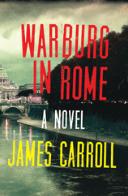 Warburg
in Rome by James Carroll Warburg
in Rome by James CarrollWarburg in Rome
is a historical novel that presents a litany of evil, shame and
suffering: the evil of sadism fueled by greed, hatred and lust; the
shame of those who could have acted against the evil sooner and more
forcefully; and the suffering of pretty much everyone. If you are
looking for a cheery read, do not look here. If you are looking for the
details of some of the history of WWII and post-WWII coming to life, at
least a bit, Warburg in Rome is a book that can offer you that.
At the beginning of the book, which I received as a
review-copy, David Warburg, the main protagonist of Warburg in Rome,
is given the War Refugee Board's posting abroad, in Rome, Italy. Much
of the early part of the book consists of flashback accounts of the
events that precede the liberation of Rome. The post liberation period
in Rome is where most of the book's story takes place. The flashback
sequences continue throughout the book.
Part One of Warburg in Rome describes Rome
in the immediate aftermath of its liberation, and we are given an idea
of the enormous scale of the relief effort needed to feed, house and
clothe the people left in war-ravaged Rome, Italy, only one of the many
European cities that had to cope with post war refugees.
Part Two of Warburg in Rome deals with the
period after the Unconditional Surrender of Nazi Germany. Warburg
remains in Rome, despite the War Refugee Board being shut down. He
works to help Jews find refuge away from the societies that had turned
on them, away from the camps where they had been sent to die.
While advertised as a "thriller", the book does not
move quickly enough, for me, to be really thrilling. The historical
subjects are all in the history books, especially the more recent
history books, so the outcomes are not in question, making the story
intrinsically un-thrilling.
Warburg in Rome is a historical novel; there
is no doubt about that. The history is richly detailed and broadly
researched, letting us inside the U.S. government, the various
militaries, the Vatican, the various resistance movements, and the
multiple relief efforts.
The characters are interesting but I never
connected with them, probably because my life is so different from their
lives. I could admire them and despise them, but caring for any one of
them was difficult. Most of the characters are so damaged that they
barely care for themselves.
I found myself admiring those few characters who
had been battered into pulp by their war experiences, but who still
found the ability, or gift, to care enough to try to end the suffering
of others. The author makes it very clear that those persons' helping
of others provides the only salve that can begin the healing of the
wounds their souls have suffered. But even some of those characters'
compassion succumbs under the relentless evil to which they are
subjected or to which they see others subjected.
Please read my
full review at
Italophile Book Reviews.
|
|
 The
Serpent of Venice by Christopher Moore The
Serpent of Venice by Christopher MooreDo
you enjoy the sketches and films of the British comedy troupe Monty
Python? Can you appreciate Shakespeare's plays? Are you an Anglophile
as well as an Italophile? If you answered "Yes!" to all three of those
questions, then you should enjoy reading The Serpent of Venice.
In a faux British and or Elizabethan English writer
Christopher Moore follows his comic creation, Pocket the King's Fool
from the novel Fool, through his next adventure in his storied
life. Surrounded by settings, characters, and storylines from
Shakespeare's plays and one Edgar Allan Poe short story, Pocket jokes
his way through Medieval Venice, Italy (1299), Venetian Corsica, and
Genoa in The Serpent of Venice. The chapters often read like
scripts for Monty Python sketches. I even found myself imagining the
female characters as men in drag with screechy falsetto voices.
The dialog is full of period puns, and period and
up-to-date vulgarity, as well as self-referential jokes. Events are not
described chronologically, the language can be mindbogglingly vulgar,
and the humor can wear thin after a while, since it is generally more
difficult to appreciate this kind of humor reading it, as opposed to
watching it performed. Those are the three reasons I found it best to
read The Serpent of Venice in small doses. That kept the humor
fresh, but it did make it difficult to follow the plot.
There is also violence in novel, coming mainly from
the creature in the Lagoon that is The Serpent of Venice.
Reading about the gore is less upsetting than seeing it, however, so if
you dislike horror stories, you might still like The Serpent of
Venice.
If you are up to
American-Monty-Python-does-Shakespeare-in-Venice then you are ready for
The Serpent of Venice. Take it in small doses, and enjoy the
author's invention, his facility with language, and especially his
facility with vulgarisms. If you try to picture it performed while you
read, you will enjoy it more, since reading The Serpent of Venice
is much like reading a Shakespearean farce, or the screenplay for Monty
Python's Life of Brian; they pale compared to the performance of
the text.
Read my
full review at
Italophile Book Reviews
|
|
 Gifts For Ugo Gifts For Ugo by Joseph C. Sciarillo
by Joseph C. SciarilloFrom the book's description:
"Family wealth and status demand much from Ugo Sacco. His father
sends him to Italy’s finest schools before he enters the seminary where
noble blood and a sharp mind make him stand out. Ugo believes the Church
will someday make him Cardinal or Bishop. He believes that fate chose
him to lead. He also believes that he will not fail.
"First of his peers, the church gives him his own parish in a remote
village Fignola, Province Potenza. Farmers and artisans, the earthy
Fignolans, warmly welcome the refined priest. ...Ugo believes the Church
owes him a better station among people of his class. ...In 1910, Ugo
believes the Church has wasted its best priest, him.
"The story begins when the bishop sends a long overdue successor to the
former assistant lost to a fever two years before. The replacement one
day just walked into the square. Ugo had not even met the new padre,
Matteo Colio. He came with no forewarning or introduction."
From an Reader Review: "This book was a pleasant surprise. A
heartwarming story of life in a small town in Italy whose inhabitants
are financially poor but rich in spirit and love. It reminded me of how
my ancestors probably lived before coming to America. The town's pastor
is the central character (along with his associate priest) and each
family was a story, some funny and some sad. It was well written and
very enjoyable to read." |
|
 Christ Stopped at Eboli Christ Stopped at Eboli by Carlo Levi
by Carlo Levi
Reviews of this modern classic:
"A kind a gray El Greco
beauty."
--Lewis Gannett, New York Herald Tribune "Has
been called in turn a diary, an album of sketches, a novelette, a
sociological study and a political essay. It has more than a trait of
each genre; yet it remains as hard to classify as every beautiful book,
or as the man who wrote this one."
--The New York Times Book
Review "A sensitive and gifted writer with
a great sense of style . . . Perhaps the best thing in [Levi's] book is
the detachment by which he avoids sentimentalizing the peasants and at
the same time renders their undestroyed feelings for human values."
--Alfred Kazin
|
|
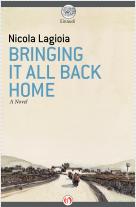 Bringing
It All Back Home by Nicola Lagioia Bringing
It All Back Home by Nicola Lagioia
Bringing It All Back Home (the name of a famous album by Bob Dylan)
is a translation from the original Italian of the award-winning novel
Riportando tutto a casa. It is a coming-of-age story that ends in
an "abyss of regret and sleepless nights" from which the narrator has
yet to escape, in the words of the narrator himself.
The changes that took place in Italy during the
1980s are portrayed through the adult intellect of a man looking back
critically and sardonically at his and his country's Regan-era boom
years. The narrator comes to recognize the huge socio-economic and
moral divide that exists between his generation and his parents'
generation, and the marked moral lapses they both share.
Being the '80s, and being about teenagers, three in
particular, there are lots of pop-culture references and song lyrics to
set the scenes, and to pad out the minimal plot. The young adults'
relationships with their parents are the main points of the book, along
with the relationships of the young people with each other, and with the
world at large.
The author is clearly well-read and well-studied,
and he possesses a literary fluency, dotted with rich, associative,
poetic passages. There are times when the verbosity tends to excess and
showiness, and there are times when the line between art and vulgarity
is crossed. The translation is excellent, as is the editing. Often the
chapters left a nasty taste in my mouth, as if the author's and the
narrator's cynicism was contagious. The details of the novel suggest it
is partially autobiographical.
I would imagine the appeal of the book would be
mainly to people who lived through the times depicted, who might want a
nostalgic look back through eyes that have become as wise as their own,
or wiser. All the major historical and social events are mentioned, and
'80s fashion is described throughout.
As a non-Italian, but one who lived in Italy during
this period, the appeal is more of curiosity and as a means of seeing
Italy through the eyes of an extremely expressive local. If you are a
non-Italian, the appeal might be to see your 1980s from a different
angle, from the perspective that comes from life in Bari, Apulia.
Please visit my
Italophile Book
Reviews site for the
full, illustrated review.
|
|
|
Where the Hell have you Been? by Tom Carver From The Economist:
"When General Montgomery's stepson,
Richard Carver, was captured by the Afrika Korps two days after the
battle of El Alamein in November 1942, he had every reason to be
worried. If the Germans had established the family connection, he
would have been sent to Colditz, with other prominent allied prisoners.
yet they never discovered the link, so instead he was sent to a prison
camp in northern Italy, from where he and 600 other allied prisoners
were released, minutes before the Wehrmacht arrived, by the commandant
when Italy left the axis in September 1943.
"Richard Carver's grueling
three-month journey of over 400 miles (650 km) on foot, from the prison
north of Parma to the allied lines south of the Sangro river, forms the
meat of this book written by his son, Tom, a former BBC correspondent.
He had to dodge German pursuers, sleep in caves, rely on the hospitality
(and courage) of Italian villagers, go hungry for days, sleep rough and
trust his home-made compass to get him back to safety.
When he was
reunited with his stepfather (General Montgomery) over a year after he
had gone missing, Monty's first words were 'Where the hell have you
been?'" |
|
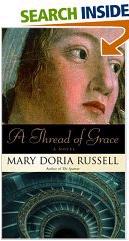 A Thread of Grace A Thread of Grace by Mary Doria Russell
by Mary Doria Russell
From Publisher's Weekly:
"...chronicles the Italian
resistance to the Germans during the last two years of WWII. Three
cultures mingle uneasily in Porto Sant'Andrea on the Ligurian coast of
northwest Italy—the Italian Jews of the village, headed by the chief
rabbi Iacopo Soncini; the Italian Catholics, like Sant'Andrea's priest
Don Osvaldo Tomitz, who befriend and shelter the Jews; and the occupying
Germans invited by Mussolini's crumbling regime..."
|
|
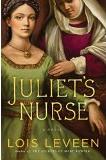
Juliet's Nurse by Lois Leveen
This is a richly imagined and deeply researched
historical novel, set in Europe's late Middle Ages, and told in a
lilting narrative voice. The narrator is the title's Juliet's nurse,
Angelica, the wet-nurse to the young Juliet Cappelletti, the daughter of
a wealthy citizen of Verona, Italy.
The author of Juliet's Nurse has imagined the life
of Juliet's nurse, an often comic character in the play, and certainly a
woman of low birth.
When the woman's difficult life is imagined and
told in the first-person, however, we get to meet a real woman who has
suffered not just hardship, misogynistic persecution and starvation, but
the loss of all her children to disease.
Because our narrator is a servant from a working
class we get an insight into what life was like for the working poor of
that era. But the servant, Angelica, works in the home of one of
Verona's wealthiest families, so we get an insight into the lives of the
rich, too.
The low stature of women, and the sexual use of
young girls that was common during Europe's Middle Ages is striking to
our modern sensibilities, but it would be familiar to anyone living in
modern Afghanistan.
There is much history for the lovers of historical
fiction to relish: herbs, medicines, customs, food, sweets, houses,
décor. There are some twists and surprises along the way, in the story,
but I won't spoil them for you.
The book is well-written and well-edited, and I'm
glad I requested a review-copy. It has a striking cover. Juliet's
Nurse is a quality production, with an attractive interior design that
features illuminated first letters of each chapter, in the style of the
era in which it is set.
This was a read that took me away from the world
around me and immersed me in a past that seemed a bit familiar, due to
the characters I knew from the play. I enjoyed it!
Please read my
full and illustrated review at Italophile Book Reviews.
|
|
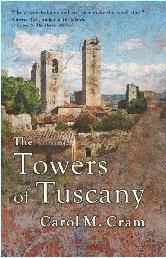
The Towers of Tuscany by Carol M. Cram
The Towers of Tuscany is a fictional
biography of an Italian woman born in the early years of the Italian
Renaissance, or the late years of the Middle Ages, depending on your
classification.
The sense of place, San Gimignano and Siena, is
very strong in The Towers of Tuscany. Reading the book, I felt I
was walking the streets of the medieval towns, and looking at the art
that adorns them. The book is rich with historical detail, and rich
with artistic detail.
Art is the driving force of The Towers of
Tuscany, and for the character of Sophia. I felt compassion for the
woman and sympathy, but overall, I did not like Sophia, just as it is
difficult to like driven people in any time and any place.
Like most women in her misogynistically repressive
time, Sophia's life was limited, difficult, and at times horrendous.
She suffers violence and rape at the hand of her husband.
Early on in The Towers of Tuscany we learn
that Sophia is suffering severely from her loveless and violent
situation. When a chance to escape her situation occurs, Sophia is
forced into living in another psychologically damaging situation. There
really is no escape for this poor woman.
At a certain point I found myself thinking of the
French film The Return of Martin Guerre, that was re-made in
English, by and starring Jodie Foster, as Sommersby. If you
enjoyed those films, and you enjoy historical novels with female
protagonists, you should like The Towers of Tuscany.
Please read my
full review at
Italophile Book Reviews.
|
|
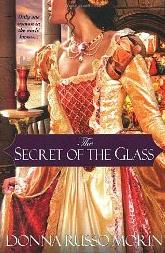
The Secret of the Glass by Donna Russo Morin
The
Murano glassmakers of Venice are celebrated and revered. But now three
are dead, killed for attempting to leave the city that both prized their
work and kept them prisoner.
For in this, the 17th century, the secret of their craft must, by
law, never leave Venetian shores. Yet there is someone who keeps the
secret while defying tradition. She is Sophia Fiolario, and she, too, is
a glassmaker. Her crime is being a woman… |
|
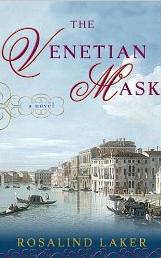
The Venetian Mask by Rosalind Laker
In
1775 Venice–known to outsiders as “the brothel of Europe”–the tradition
of mask-wearing has allowed adultery and debauchery to flourish. But
Marietta and Elena, two dear friends at the Ospedale della Pietà, a
world-famous orphanage and music school for girls, know little of that
milieu–until they come of age.
Elena is forced to wed the head of the Celano clan, a jealous, brutal
man, while Marietta marries Domenico Torrisi, whose family vendetta with
the Celanos is centuries old. Tradition dictates that the friends should
never speak again, but their bond is too strong to break.
|
|
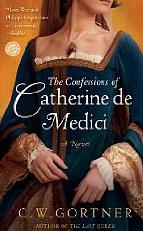
The Confessions of Catherine de Medici by C. W. Gortner
Kindle
book and other editions available, from the publisher:
One of the great joys in
literature is finding a novel that invests us in the formative years of
a child and follows her life, the twists and turns, the unexpected
roadblocks, the ingenuity of an original mind at work, leading to
triumph, despair or tragedy.
The Confessions of Catherine de Medici is one of those rare
pleasures. Penned by the sure hand of C. W. Gortner, there is never a
missed step. Confident gestures, psychological insights, the terror of
fighting a nation-altering change in consciousness are all handled
masterfully. |
|

The Devil's Queen by Jeanne Kalogridis
Kindle
book and other editions available, from the publisher:
History can be dry and
uninspiring, but Kalogridis infuses Catherine de Medici's life from
1527-1572 with the unique characteristics of a Medici and the unfolding
events of history, the melding of politics and superstition.
Although it is impossible to include all the nuances of these
turbulent years, the author focuses on Catherine's life from her
imprisonment in Florence to her regency in France and the gruesome St.
Bartholomew's Day Massacre of 1572. |
|
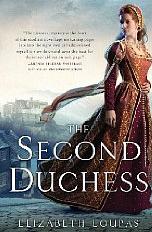
The Second Duchess by Elizabeth Loupas
Kindle
book and other editions available, from the publisher:
In a city-state known for magnificence, where love affairs and
conspiracies play out amidst brilliant painters, poets and musicians,
the powerful and ambitious Alfonso d'Este, duke of Ferrara, takes a new
bride. Half of Europe is certain he murdered his first wife, Lucrezia,
the luminous child of the Medici. But no one dares accuse him, and no
one has proof-least of all his second duchess, the far less beautiful
but delightfully clever Barbara of Austria.
At first determined to ignore the rumors about her new husband,
Barbara embraces the pleasures of the Ferrarese court. Yet wherever she
turns she hears whispers of the first duchess's wayward life and
mysterious death. Barbara asks questions-a dangerous mistake for a
duchess of Ferrara. Suddenly, to save her own life, Barbara has no
choice but to risk the duke's terrifying displeasure and discover the
truth of Lucrezia's death-or she will share her fate. |
|

The Scarlet Contessa by Jeanne Kalogridis
Kindle book and other editions available, from the publisher:
This vividly rendered historical takes readers to tempestuous
Renaissance Italy, where city-states and noble families battle for
supremacy over Italy and, through the papacy, the world.
Caterina Sforza comes into power by marrying the illegitimate son of
Pope Sixtus, and while her husband is slothful and suspicious, Caterina
is clever and ambitious, allying herself with powerful men to ensure her
family's success throughout tumultuous times. |
|
|
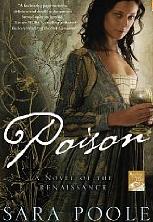 Poison
by Sara Poole (a mystery series) Poison
by Sara Poole (a mystery series)
Poole’s
novel begins this historical-mystery series starring Francesca
Giordano, a young woman who takes over her father’s job as head poisoner
for the Borgia family.
Working for Cardinal Borgia as he attempts to become pope is a deadly
and dangerous business—Francesca’s father is already dead in mysterious
circumstances, and threats lurk everywhere. But Francesca has one key advantage; no one takes a
woman seriously. That’s unfortunate because Francesca happens to be one
of the greatest poisoners in late-fifteenth-century Rome.
These are the books in the (Poisoner Mystery) series so far:
- Poison - a Novel of the Renaissance
- The Borgia Betrayal
- The Borgia Mistress
|
|
|
The Botticelli Trilogy by Linda Proud (A Tabernacle for the
Sun, Pallas and the Centaur, The Rebirth of Venus)
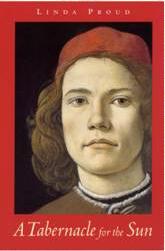
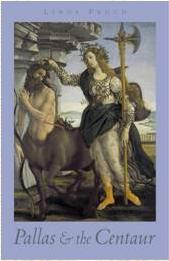
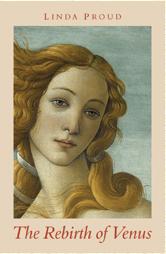
This trilogy by historian/novelist Linda Proud is a real
accomplishment. She manages to bring to life Lorenzo de'
Medici's Italy through characters key to the Italian Renaissance,
but never loses sight of the human aspect of that time of clashing
ideas from the Medieval and from the rebirth of classic knowledge and
philosophy.
I link to her publisher's site,
Godstow Press, where you can read about the books and
enjoy excerpts from the three novels. You can purchase the books
via Amazon.uk.
A
Tabernacle for the Sun is told by Tommaso de' Maffei, whose
story involves the Pazzi Conspiracy against the de' Medici, and many
thinkers and artists of the time including Marsilio Ficino, Angelo
Poliziano, Lorenzo de' Medici, Botticelli and Filipino Lippi.
Excerpt.
My review on this site.
Pallas and the
Centaur takes up where the first book leaves off and is told by
Angelo Poliziano, poet and intellectual. The Pazzi Wars follow the
assassination attempt on the de' Medici, which took the life of
Lorenzo's brother, Giuliano. But there is a war of ideas that is
just as heated, between superstitious Medieval, God and church centered
Europe, and the new Europe of the rational, man-centered neo-Platonists.
Excerpt.
The Rebirth of
Venus is a chronicle by Tommaso de' Maffei written for Erasmus, whom
he will accompany to Florence. It details Tommaso's life in
Florence under Lorenzo de' Medici's rule, after the Pazzi Wars are over.
Tommaso becomes a printer and eventually moves to Venice, then to
London. He is in exile because be became too closely involved with
the charismatic, religious extremist Savonarola.
Excerpt (pdf).
Visit Ms. Proud's website
for some itineraries to consult before your next visit to Florence.
And there is an entry
at Wikipedia about her, too. For a brief history of the De' Medici
dynasty, visit my Medici pages. |
Read
my review of A Tabernacle for the Sun
here on this site.
Purchase the books via
Godstow Press
or via
Amazon.uk. |
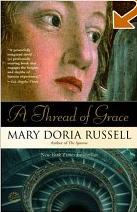 A
Thread of Grace by Mary Doria Russell A
Thread of Grace by Mary Doria RussellFrom Amazon.com:
Mary Doria Russell's extraordinary and
complex historical novel, A Thread of Grace, is the kind of book
that you will find yourself haunted by long after finishing the last
page. It opens with a group of Jewish refugees being escorted to
safe-keeping by Italian soldiers. After making the arduous journey over
a steep mountain pass, they are welcomed into a small village with warm
food and clean beds. They have barely laid their heads to rest when news
is received that Mussolini has just surrendered Italy to Hitler, putting
them in danger yet again. This opening sequence is a grim foreshadowing
of the heart-breaking journey these characters will experience in their
struggle for survival.
The rich fictional narrative is woven through the factual military
maneuvers and political games at the end of WW II, sharing a
little-known story of a group of Italian citizens that sheltered more
than 40,000 Jews from grueling work camp executions. Rather than the
bleak and hopeless feeling that might be expected, the novel has the
opposite effect; it reminds us that just as there will always be war,
crime, and death, so too will there be good people who selflessly
sacrifice themselves to ease the suffering of others. Perhaps best of
all, Russell succinctly opens and closes her writing with short pieces
that bookend the story with the force of a freight train. Her moving
finale wraps up her narrative in the present day, with a death bed scene
that's sure to rip the heart out of readers of every faith and ancestry. |
|
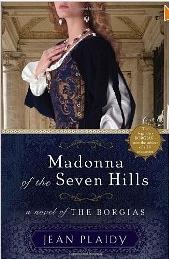
Madonna of the Seven Hills by Jean Plaidy and
Light on Lucrezia by Jean Plaidy
Fifteenth-century Rome. The Borgia family is on the rise.
Lucrezia’s father, Pope Alexander VI, places his illegitimate daughter
and her only brothers, Cesare, Giovanni, and Goffredo, in the jeweled
splendor—and scandal—of his court.
A family epic legend
replete with passion, intrigue, and murder.
There are two books to the series:
- Madonna of the Seven Hills
- Light on Lucrezia
|
|
|
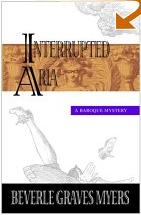 Interrupted
Aria by Beverle Graves Myers (mystery series) Interrupted
Aria by Beverle Graves Myers (mystery series)
This is the first in a series of historical mysteries set in 1700s
Venice featuring an opera singer as the amateur detective. Tito
Amato is no ordinary opera singer. He is a castrato, a male
soprano, created by a surgeon's knife. His multi-octave voice has
a power that female sopranos can only envy. The price? He
can never marry in a Catholic ceremony, nor can he father children.
From a Reader Review: "Filled with lush description of Venice
during Carnivale, its political and social structure, the inner workings
of the opera company and Tito's relationships with his family, friends,
colleagues and himself, this is a rich, wonderful book. I also found it a good mystery with a couple of twists and some good
suspense. This is a series I shall definitely follow." Here
are links to the other entries in the "Tito Amato" series at Amazon.com:
Tito Amato Series Books in order of publication:
- Interrupted Aria
- Painted Veil
- Cruel Music
- The Iron Tongue of Midnight
- Her Deadly Mischief
I have read all the books in this series and I
recommend them highly.
The author is a wonderful writer who manages to create vivid
characters set in an era long ago that comes to life in the writer's
capable and erudite hands.
While at times the mysteries are not so mysterious, I've read each
book to the end, if only to enjoy the characters, setting, and
delightful writing.
Some of the books end on a very somber note, which I didn't enjoy, but
the journey getting there was always entertaining. I especially respect the writer for writing the books in the
1st-person-narrative style, as if we were reading her character Tito
Amato's memoirs about his amateur detective cases.
So many writers these days use the 3rd-person-limited style (the "I"
turned to "he"), that it is refreshing to read a book in an undisguised
1st-person-narrative style. It brings us closer to her unique
protagonist. My favorite book in the series is the last one, published in 2009,
Her Deadly Mischief. On the author's
website, she says she
is busy writing the next book in the series. I certainly hope that
is true. I look forward to its release!
Note:
The links I offer are to Amazon.com. But I recommend you look
for these books either at the
Poisoned Pen Press website, or for
great prices, secondhand, from
Better World Books, who
ship worldwide for free. |
|
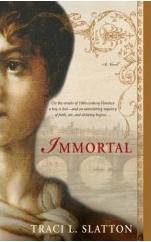 Immortal
by Traci L. Slatton Immortal
by Traci L. SlattonFrom a Reader Review: "The setting, for me,
couldn't be better: the city of Florence and its environs during the
Italian Renaissance.
'This is a period of history that I continue to study with particular
interest. Combining a fictional protagonist, Luca Bastardo ("Luca the
bastard"), with actual historical personalities, such as Giotto di
Bondone, Leonardo da Vinci, the Medicis, and so forth, along with actual
historical events such as the Inquisition and the terrible medieval
plague..."
For a brief history of the De' Medici dynasty, visit
my Medici pages. |
|
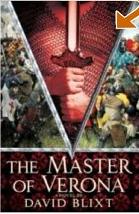 The
Master of Verona by David Blixt The
Master of Verona by David BlixtFrom a Reader Review: "Have
you ever wondered why the Montagues and Capulets of Romeo and Juliet
began their famous feud? David Blixt has, and in answer, he gives us The
Master of Verona.
'Yet, The Master of Verona isn't so much about the feud (though it is in
there) as it is about Congrand della Scala. Told through the perspective
of Pietro Alagheri, son of Dante (The Inferno), we catch a slice of
Veronese life on the brink of Renaissance.
'The cast of characters is enormous (and, thankfully, it is provided at
the beginning of the book). Fictional characters intermingle with
historical figures as well as Shakespearian figures. They all have names
like Gargano Montecchio and Marsilio Da Carrara, and if it isn't enough
that most of the names sound like someone else's, they all have
nicknames as well. All that is said to say that to read this book is a
commitment. But if you'll hang in there for a few chapters (and refer
regularly to the cast), it will be worth it." |
|
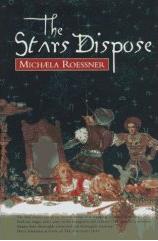 The
Stars Dispose by Michela Roessner The
Stars Dispose by Michela RoessnerSet in Renaissance Florence and
featuring the de' Medici's cooks!
From Library Journal: "The Befanini family rules the kitchens
of the de Medici and their allies, serving well by fortifying their
patrons' reputations and influence with all the power that a brilliant
meal can supply.
'Young Ginevra Befanini serves more directly as companion and
confidante to Caterina de Medici, while Ginevra's brother Tommaso is
learning his family's craft and enhancing it with his own ideas and
talents.
'The political forces of Renaissance Florence pull and push at them;
plague stalks them; and other alien forces move through the kitchens and
the city, menacing Caterina and her friends."
For a brief history of the De' Medici dynasty, visit
my Medici pages. |
|
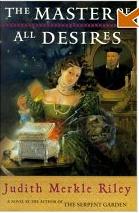 The
Master of all Desires by Judith Merkle Riley The
Master of all Desires by Judith Merkle Riley(While set in France,
it deals with Italy's de' Medici family.
For a brief history of the De' Medici dynasty, visit
my Medici pages.)
From Amazon.com:
"While Catherine de Medici, Queen of France, uses her sorcerous talents
to oust royal mistress Diane de Poitiers from her favored position in
the French court, the true future of France rests in the hands of a
young poetess who possesses a powerful and dangerous magical relic.
'Riley laces her portrayal of 16th-century France with liberal doses
of magic (including the enchanted head of a dead wizard), politics,
poison, and prophecy. The author of The Serpent Garden once again
approaches historical fantasy with her characteristic flair for
intrigue, humor, and the unpredictable workings of the human heart." |
|
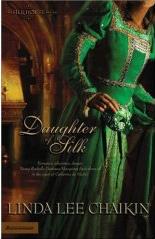 Daughter
of Silk by Linda Lee Chaikin Daughter
of Silk by Linda Lee Chaikin(While
set in France, it deals with Italy's de' Medici family.
For a brief history of the De' Medici dynasty, visit my
Medici pages.)
From a Reader Review: "This story
is one of the best researched, well-written books I have ever read.
'The fictional characters are very believable and representative of
the people who had really lived during the time of Catherine de Medici's
rule over France.
'The history is very accurate and Linda portrays the schemes of the
Queen Mother so accurately that I felt shivers ever time she enters her
mind..." |
|
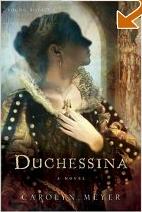 Duchessina
by Carolyn Meyer Duchessina
by Carolyn MeyerA novelized account of Caterina de' Medici's early
years.
From Amazon.com: "Young Catherine de' Medici is the sole
heiress to the entire fortune of the wealthy Medici family. But
her life is far from luxurious.
'After a childhood spent locked away behind the walls of a
convent, she joins the household of the pope, where at last she
can be united with her true love.
'But, all too soon, that love is replaced with an engagement
to a boy who is cold and aloof. It soon becomes clear that
Catherine will need all the cunning she can muster to command
the respect she deserves as one of France's most powerful
queens.
For a brief history of the De' Medici dynasty, visit
my Medici pages.
|
|
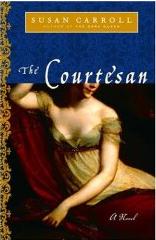
The Courtesan by Susan Carroll
(While
set in France, it deals with Italy's de' Medici family.
For a brief history of the De' Medici dynasty, visit my
Medici pages.)
From Amazon.com: "Paris, 1575. The consort of some of Europe’s
most influential men, Gabrielle Cheney is determined to secure her
future by winning the heart of Henry, the Huguenot king of Navarre. As
his mistress, Gabrielle hopes she might one day become the power behind
the French throne.
'But her plans are jeopardized by Captain Nicolas Rémy, a devoted
warrior whose love Gabrielle desires–and fears–above all. She will also
incur the malevolence of the Dark Queen, Catherine de’ Medici, whose
spies and witch-hunters are legion, and who will summon the black arts
to maintain her authority." |
|
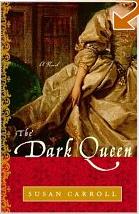
The Dark Queen by Susan Carroll
(While
set in France, it deals with Italy's de' Medici family.
For a brief history of the De' Medici dynasty, visit my
Medici pages.)
From a Reader Review: "I stumbled upon this book one day looking
for a book to get lost in in between semesters of grad school and I am
extremely happy that I did so. The first couple of chapters were a
little slow for me, but it really picked up around the 7th or 8th
chapters. I can't believe I read 500 pages so quickly!
'It's not rocket science or anything, but if you are looking for above
average historical fiction with plenty of romantic scenes in which to
escape and the ever popular battle between good and evil,than this is
the novel for you.
'Overall, I thoroughly enjoyed this book and am on my way to get the
Cortesan as I type. Oh, and by the way, the way this woman describes
kisses is simply delicious."
This historical fiction deals with Caterina de' Medici when she was
Queen of France and her machinations to marry off her daughter,
including murder. |
|
 Artemisia
by Alexandra Lapierre Artemisia
by Alexandra LapierreFrom Publisher's Weekly: "LaPierre's
heavily researched but racy historical novel covers the passionate life
of Italian Renaissance artist Artemisia Gentileschi (1592-1653), who
survived rape, ostracism and public scandal and went on to imagine
powerful women in her energetic paintings.
Artemisia's father was
the much-in-demand Roman painter Orazio Gentileschi, who took the
unusual steps of making his daughter both his apprentice and his model.
As Artemisia entered her late teens, Orazio grew extremely protective,
then arranged for her to marry his unscrupulous associate, painter
Agostino Tassi. When Artemisia refused Tassi... Rave reviews
by readers who love art, the Italian Renaissance and great drama all
tied into an historical novel." |
|
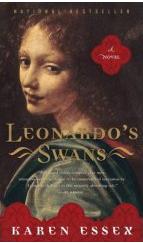 Leonardo's
Swans by Karen Essex Leonardo's
Swans by Karen EssexFrom the Washington Post: "The
novel centers on two sisters in late 15th-century Italy: Isabella
and Beatrice d'Este of Ferrara. As the book opens, the sisters
prepare for marriage: the beautiful Isabella to the handsome Francesco
Gonzaga, and the tomboyish Beatrice to the rakish and scheming Ludovico
Sforza, regent to the duke of Milan. Isabella is very happy with
this arrangement. Francesco may not be the most influential man in
Italy, but he's a looker and an important soldier. Ludovico,
however, is reputed (the girls have never seen him) to be ancient
(nearly 40), dissolute and morally repulsive." More rave reviews
for this book that delves deeply into the lives and surrounding history,
including Leonardo da Vinci, of these important persons from Italy's
Renaissance. |
|
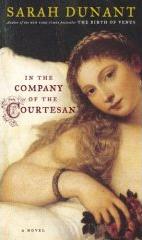 In
the Company of the Courtesan by Sarah Dunant In
the Company of the Courtesan by Sarah DunantFrom Publisher's
Weekly: "...Dunant crafts a vivid vision of Venetian life: the
weave of politics and religion; the layers of class; the rituals,
intrigue, superstitions and betrayals. Dunant's characters—the
steely courtesan whose glimpse of true love nearly brings her to ruin;
the shrewd and passionate dwarf who turns his abnormalities into
triumph; and the healer whose mysterious powers and secrets leave an
indelible mark on the duo—are irresistible throughout their shifting
fortunes."
There is another Sarah Dunant book further down this page. |
|
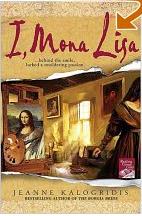 I,
Mona Lisa by Jeanne Kalogridis I,
Mona Lisa by Jeanne KalogridisFrom a Reader's Review:
"After having loved "The Borgia Bride" by Jeanne Kalogridis, I was
looking forward to "I, Mona Lisa" with high expectations and was
delighted to pour through this wonderful novel filled with historical
fact blended with innovative fiction, and twists and turns galore. Set
in Florence in the 1490s, the novel tells the story of Madonna Lisa, the
woman behind Leondardo DiVinci's masterpiece. The story is a clever and
romantic possibility of the reason behind that famous smile (or lack
thereof?).
'If you enjoy historical fiction, "I, Mona Lisa" and "The Borgia Bride"
are two examples of the genre at its finest: wonderful character
development, rich plots, a studied knowledge of the place, times and
characters (you will recognise famous historical figures throughout both
novels), a careful weaving of fact and fiction, and just enough twists
and turns to keep the modern reader both interested and engaged. I
highly recommend both novels!
'P.S. DO NOT READ THE BACK OF THE BOOK PRIOR TO READING IT!!!! Whomever
wrote the blurb on the back of this novel certainly didn't want the
readers to be shocked about one of the interesting plot-twists more than
halfway through the novel. If you want to be surprised and enjoy this
book to its fullest, I highly recommend NOT reading the back of the
book!"
There is more Jeanne Kalogridis books on this page. |
|
|
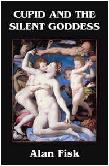 Cupid and the Silent Goddess Cupid and the Silent Goddess by Alan Fisk
by Alan Fisk
From Reviews:
"...captures the atmosphere of sixteenth-century Florence and
the world of the artists excellently. this is a fascinating
imaginative reconstruction of the events during the painting of Allegory
with Venus and Cupid." Marina Oliver, historical novelist.
"A witty and entertaining romp set in the seedy world of Italian
Renaissance artists." Elizabeth Chadwick, award-winning historical
novelist.
You can read
the first chapter on-line, and reviews from other authors. The
painting on the cover, and described in the book, is by Bronzino and is
currently in the collection at the National
Gallery in London. Another look at the painting...
I've read this book and I can recommend it highly. It
brought me into the 16th century Florentine life, with all it's warts,
humanity, politics and art. A very enjoyable read.
It's set during the time of Cosimo de' Medici, and features
the artist Bronzino. The author traces Bronzino's work on the
famous Cupid and the Silent Goddess making the figures in the painting
characters in his novel. I didn't want the book to end! The
characters were so interesting, I wanted the story to just keep on
going. Candida Martinelli
|
|
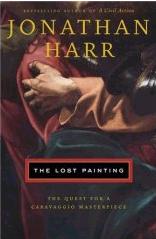 The Lost Painting: The Quest for a Caravaggio Masterpiece
by Jonathan Harr
The Lost Painting: The Quest for a Caravaggio Masterpiece
by Jonathan Harr
From a Reader Review: "This true story reads like a novel,
fast and full of intrigue. It takes you through the streets of Rome,
both in the present as well as 400 years ago. Harr brilliantly explores
the science of art history through the eyes of a student, then throws
you into a world of art restoration, with the suspense of a murder
mystery. It's a book you can't put down from the opening paragraph.
Definitely a must read for any interest." Very positive
reviews and high rating!
|
|
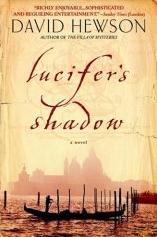 Lucifer's
Shadow by David Hewson Lucifer's
Shadow by David HewsonFrom Booklist: "This
intelligent and highly detailed thriller by British author Hewson (A
Season for the Dead, 2003) rivals Perez-Reverte's The Flanders
Panel (1994) in historical intricacy, complexity of motive, and
multileveled storytelling. Masterfully plotted, the novel alternates
between present-day and eighteenth-century Venice, following flawed and
unwary innocents down the devil's path, tempted by visions of fame,
personal glory, and love." |
|
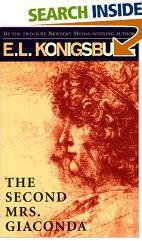 The Second Mrs. Gioconda The Second Mrs. Gioconda by
E. L. Konigsburg by
E. L. Konigsburg
From the Publisher: "The Mona Lisa... Why did Leonardo da
Vinci lavish three years on a painting of the second wife of an
unimportant merchant when all the nobles of Europe were begging for a
portrait by his hand?
No one knows for sure. But this story of Leonardo, his wayward
apprentice Salai, and the Duke of Milan's plain young wife, Beatrice
d'Este, may hold the clue to the most famous -- and puzzling -- painting
of all time."
|
|
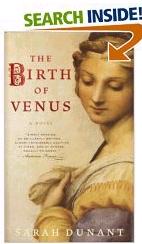 The Birth of Venus The Birth of Venus by Sarah Dunant
by Sarah Dunant
From Amazon.com: "Sarah Dunant's gorgeous and mesmerizing novel,
Birth of Venus, draws readers into a turbulent 15th-century
Florence, a time when the lavish city, steeped in years of Medici family
luxury, is suddenly besieged by plague, threat of invasion, and the
righteous wrath of a fundamentalist monk. Dunant masterfully blends fact
and fiction, seamlessly interweaving Florentine history with the
coming-of-age story of a spirited 14-year-old girl..."
For a brief history of the De' Medici dynasty, visit
my Medici pages.
|
|
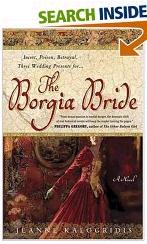 The Borgia Bride The Borgia Bride by Jeanne Kalogridis
by Jeanne Kalogridis
From Publisher's Weekly: "Against the backdrop of 15th-century
Italian internecine feuds, debauchery and Vatican corruption, Kalogridis's
latest historical novel (after The Burning Times) chronicles with
compelling sweep the story of the ravishing and iron-willed Sancha de
Aragon, princess of Naples. Illegitimate daughter to the coldhearted duke
of Calabria (briefly king of Naples), she is used to establish ties to the
feared and influential House of Borgia when her father betroths her to the
younger scion, Jofre..."
|
|
|
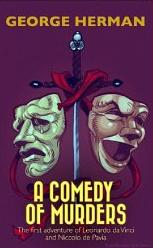 A
Comedy of Murders by George Herman A
Comedy of Murders by George Herman
A Comedy of Murders is a richly researched and richly imagined
visit to that amazing time of city-states run by princes, and
explorations of our planet and the sciences, and a church more concerned
with rich coffers than rich souls, and wars fueled by personal
vendettas, and personal vendettas fueled by wars. We meet the Duke of
Milan, the French King, the Pope, minor city-state princes, courtiers
and other hangers-on. The reader does not need to be an expert on these
times or people; the author informatively guides us through them.
Have you ever seen Richard Lester's film The Three Musketeers? While
reading A Comedy of Murders, I found myself playing a film of the
story in my mind, in the style of Lester's filming of the classic
historical adventure tale. Both tales are told as bawdy, silly,
historical farce, in which real people from the past are imagined as
flawed, corrupt, pompous idiots who are lost in circumstances beyond
their control.
There are some characters who rise above others in their moral
fortitude, and one of those is the artist-architect Leonardo da Vinci.
The author weaves Leonardo's life and work into the story, and from
about page ninety, Leonardo plays a large role in the story. A Comedy
of Murders is actually the first novel in a series of comic novels
that feature Leonardo da Vinci and his friend, the fictional Niccolo de
Pavia, a diminutive scholar and courtier.
There are eight books in the series, all historical comedies for adults
set during the height of the Italian Renaissance, full of courts,
castles, dungeons, torture, gossip, courtesans, rivalries, out-sized
egos, rampant libidos, political scheming, erudite learning, monumental
building project, and the creation of timeless art.
I would advise a reader to sit back and savor the author's masterful
recreation of that raucous, vibrant, violent, cruel and creative era. He
is especially knowledgeable about Renaissance warfare, and Leonard da
Vinci's work. Do not expect a "mystery novel". Be open to the comic
historical novel, and let history wash over you. The author makes us a
visitor to a Renaissance city-state's court, and puts us in the middle
of all the nonsense.
Read my
full review at
Italophile Book Reviews.
There are eight books in the series:
- A Comedy of Murders
- The Tears of the Madonna
- The Florentine Mourners
- The Necromancer
- The Toys of War
- The Arno Serpent
- Cardinal Virtues
- Leonardo's Labyrinth (last in the series, series ends)
Author's
Website
|
|
|
Also see my pages:
Mysteries
set in Italy
Mysteries
set in Ancient Rome
Non-fiction
books about Italy
Romances
set in Italy
Thrillers
Set in Italy
Children's
Books
Italian
Bestselling Writers
For fans of Indie E-books

Enter keywords in the
Smashwords
search bar, followed by a comma (for example: historical, fiction, italy,)
to locate the books that interest you. The books are available in
various e-book formats for immediate download. And there are over
30,000 free e-books!
|
|





 Galdir
- Protector of Rome by Fredrik Nath
Galdir
- Protector of Rome by Fredrik Nath  The
Fall of Rome by Michael Curtis Ford
The
Fall of Rome by Michael Curtis Ford Imperium
by Robert Harris
Imperium
by Robert Harris Pompeii
by Robert Harris
Pompeii
by Robert Harris Memoirs
of Hadrian by Marguerite Yourcenar
Memoirs
of Hadrian by Marguerite Yourcenar Under the Eagle
Under the Eagle Eagle in the Snow
Eagle in the Snow
 Warburg
in Rome by James Carroll
Warburg
in Rome by James Carroll The
Serpent of Venice by Christopher Moore
The
Serpent of Venice by Christopher Moore
 Christ Stopped at Eboli
Christ Stopped at Eboli Bringing
It All Back Home by Nicola Lagioia
Bringing
It All Back Home by Nicola Lagioia A Thread of Grace
A Thread of Grace







 Poison
by Sara Poole (a mystery series)
Poison
by Sara Poole (a mystery series)


 A
Thread of Grace by Mary Doria Russell
A
Thread of Grace by Mary Doria Russell
 Interrupted
Aria by Beverle Graves Myers (mystery series)
Interrupted
Aria by Beverle Graves Myers (mystery series) Immortal
by Traci L. Slatton
Immortal
by Traci L. Slatton The
Master of Verona by David Blixt
The
Master of Verona by David Blixt The
Stars Dispose by Michela Roessner
The
Stars Dispose by Michela Roessner The
Master of all Desires by Judith Merkle Riley
The
Master of all Desires by Judith Merkle Riley Daughter
of Silk by Linda Lee Chaikin
Daughter
of Silk by Linda Lee Chaikin Duchessina
by Carolyn Meyer
Duchessina
by Carolyn Meyer

 Artemisia
by Alexandra Lapierre
Artemisia
by Alexandra Lapierre Leonardo's
Swans by Karen Essex
Leonardo's
Swans by Karen Essex In
the Company of the Courtesan by Sarah Dunant
In
the Company of the Courtesan by Sarah Dunant I,
Mona Lisa by Jeanne Kalogridis
I,
Mona Lisa by Jeanne Kalogridis Cupid and the Silent Goddess
Cupid and the Silent Goddess The Lost Painting: The Quest for a Caravaggio Masterpiece
The Lost Painting: The Quest for a Caravaggio Masterpiece
 The Second Mrs. Gioconda
The Second Mrs. Gioconda The Birth of Venus
The Birth of Venus The Borgia Bride
The Borgia Bride A
Comedy of Murders by George Herman
A
Comedy of Murders by George Herman

